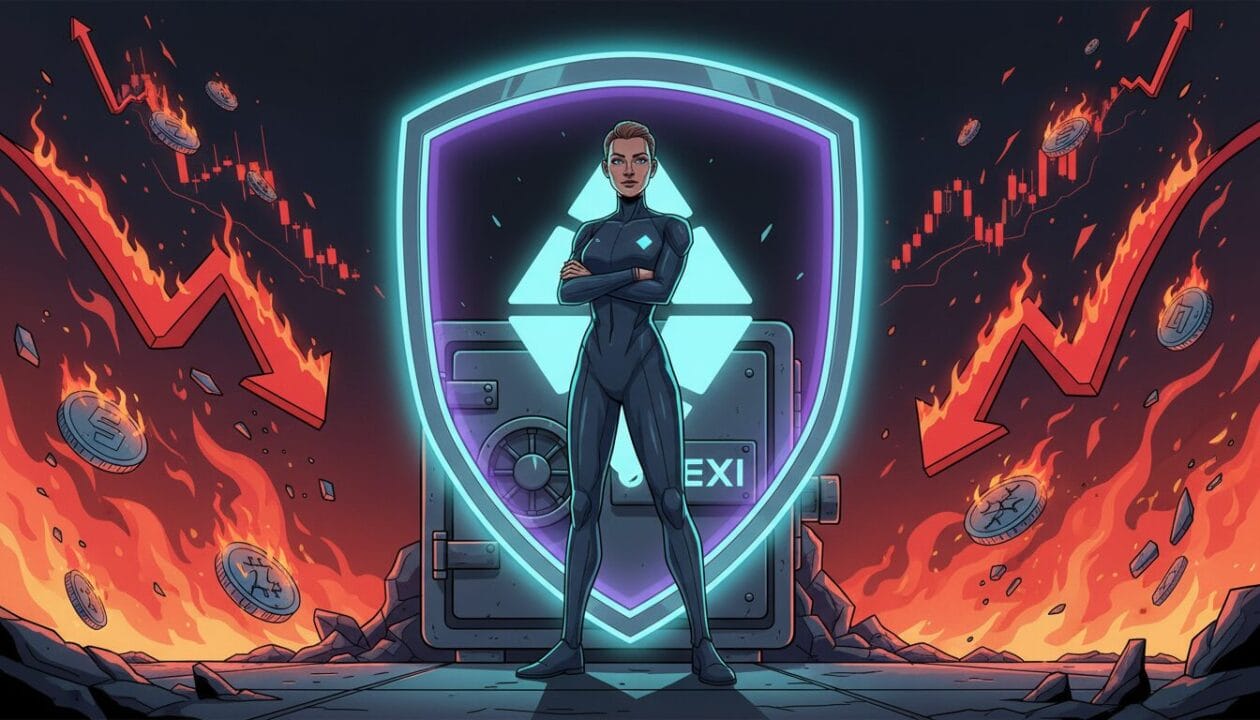Upexi’s Solana Treasury: A Strategy Built to Ignore Market Crashes

A Low-Leverage, Long-Term Approach
When the cryptocurrency market recently lost over $1 trillion in value within hours, panic was widespread. Yet for crypto treasury firms like Upexi, which hold significant spot assets, it was just another day. According to Brian Rudick, Chief Strategy Officer at Upexi, the dramatic downturn had almost no impact on their operations.
Rudick explained that Upexi follows a straightforward buy-and-hold strategy. The firm isn’t involved in aggressive on-chain trading or using leverage to chase yields. Instead, it holds spot Solana and stakes it. During a market crash, the main effect is a temporary dip in the company’s net asset value (NAV), which in this case, largely recovered.
He identifies excessive leverage as the real danger. A firm that borrows heavily against its holdings can become a forced seller if prices crash and stay low. Upexi, however, maintains a conservative position with only about $40 million in debt against roughly $400 million in Solana holdings. This low-leverage approach means market volatility doesn’t alter their strategy; it can even present an attractive entry point to acquire more assets if cash is available.
Strategic Capital and Shareholder Value
Upexi’s decisions to buy more Solana aren’t based on timing the market. Instead, acquisitions are directly tied to capital formation. The company raises funds through several methods, including convertible notes, equity private placements, and at-the-market (ATM) programs, which allow for gradual equity issuance.
The key factor, Rudick noted, is whether a capital raise is accretive—meaning it allows the company to increase its SOL holdings per share, creating shareholder value. This involves balancing investor appetite with market conditions. For instance, selling shares when the company trades at a high multiple to its NAV is highly accretive but can be difficult to achieve at scale.
Beyond strategic acquisitions, the treasury itself is a productive asset. Upexi stakes its Solana to earn an annual yield of around 8%. This return is sometimes amplified by purchasing locked SOL at a significant discount, effectively compounding value for investors over the long term.
Why Solana Over Ethereum?
Upexi’s choice of Solana as its primary treasury asset was a deliberate one. Rudick points to three core reasons for their conviction in the network. First is its technology; Solana processes transactions in parallel, a more modern architecture that boosts performance. Having launched in 2020, it benefits from newer design principles while having already established significant network effects.
Second is its versatile ecosystem. Rudick highlights its wide-ranging applications, from Decentralized Finance (DeFi) and DePIN to social media, gaming, and tokenization. This flexibility demonstrates the platform’s capacity for broad adoption.
Finally, Solana’s traction is a major factor. Key metrics such as daily active users, decentralized exchange (DEX) volumes, and decentralized application (DApp) revenues already show Solana leading in several critical areas.
A Monolithic Vision for Finance
When compared to Ethereum, Rudick argues that Solana’s architectural differences give it a competitive edge. He describes Ethereum as a network that prioritized decentralization and security, which led to performance trade-offs. This has pushed much of the ecosystem’s activity onto Layer 2 solutions—separate blockchains that capture value which might have otherwise accrued to Ethereum itself.
Solana, in contrast, took a monolithic approach by building for performance and security from the start. It handles data availability, execution, consensus, and settlement on a single layer, creating a more unified and simpler user experience without the need for bridging between different networks.
From Upexi’s perspective, Solana is purpose-built to become the fundamental infrastructure for internet-scale capital markets—providing global, permissionless access around the clock. It’s this compelling vision of the future of finance that underpins their entire treasury strategy.
A Saturated Market Spurs New Strategies
The initial wave of companies building large-scale altcoin treasuries, particularly with assets like Solana, proved to be a successful model. Early movers who executed large equity private placements to accumulate these digital assets saw significant returns. However, this success has led to a saturated market crowded with copycats, which has compressed valuations and multiples on Net Asset Value (NAV).
This new environment is forcing market participants to ask what comes next. The search is on for the “Digital Asset Treasury 2.0” model—a sustainable strategy for growth in a more competitive landscape. Several distinct ideas are emerging, each with its own set of opportunities and significant risks.
Funding Treasuries with Operating Businesses
One proposed model involves acquiring a profitable, cash-flow-positive business and using its earnings to systematically accumulate digital assets. This strategy aims to fund a corporate treasury from real-world business operations rather than relying solely on capital markets. While interesting in theory, this approach faces skepticism.
The success of a company like MicroStrategy, for example, is often attributed to its simplicity. Its core business is secondary to its primary function as a Bitcoin holding company, a straightforward strategy that investors understand. Introducing the complexity of managing an unrelated operating business could distract from the core mission and potentially diminish, rather than add, value to the treasury model.
The High-Risk Pursuit of On-Chain Yields
Another path involves moving further on-chain to enhance returns through more aggressive strategies. This could include complex staking arrangements, leveraging Decentralized Finance (DeFi) protocols, or engaging with other liquidity-generating mechanisms. Yet, this approach introduces a host of new dangers.
Companies pursuing these high yields must contend with a wider range of legal, regulatory, and smart contract risks, including the potential for liquidation. Furthermore, as more capital flows into these strategies, the yields themselves are likely to diminish. More conservative methods, such as acquiring locked tokens at a discount, can already generate substantial returns without taking on the additional, often uncompensated, risks of aggressive on-chain tactics.
The Complex Case for Mergers and Acquisitions
Mergers and acquisitions (M&A) have also become a popular topic of discussion, though the logic presents a fundamental puzzle. For a company trading below its NAV, it seems counterintuitive to sell to another firm for less than the value of its token holdings, especially when it could simply liquidate its assets directly. From the buyer’s perspective, paying a premium for another company’s assets is questionable when the same tokens can be purchased on the open market.
Beyond the strategic questions, M&A introduces significant friction, including transaction risk, legal and banking fees, and months-long processes. Market reaction is also a major variable. When Strive announced its acquisition of Semler, for instance, its stock dropped approximately 40% despite the deal being structured to increase its Bitcoin holdings per share. This highlights the steep risks involved.
Still, M&A isn’t without merit. A deal can make sense if a buyer lacks the ability to raise cash but can offer its stock to a willing seller. The resulting combined entity might achieve greater market visibility and higher trading volume, which could facilitate future equity issuance. The performance of the next few major M&A deals will likely determine whether a wave of consolidation occurs or if the trend remains subdued.
A Disciplined Path Forward
Amid these complex and often risky alternatives, a more straightforward strategy continues to hold its ground. A disciplined approach focused on raising capital accretively, staking assets responsibly, and steadily compounding the number of tokens per share over time remains a proven and effective model. For many, navigating the future of digital asset treasuries may not require reinventing the wheel but rather executing a simple, low-risk plan with precision.











